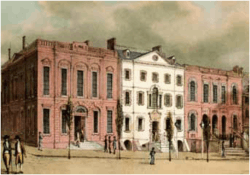1831 City Bank of New York theft

The City Bank, now Citibank, on Wall Street in New York City was burgled on March 19, 1831 in what is regarded as one of the first bank thefts in the United States. The thieves made off with $245,000 (1831 values) using a set of copied keys. [2] The amount stolen would come to over $6 million in today's currency.[1]
Initial reports variously reported the name of the culprit as Edward Smith, Edward Jones, James Honeyman[3] and James Murray[4]. A modern source, drawing on period newspapers, fingers James Honeyman and William J. Murray.[1]
Honeyman, who used both "Smith" and "Jones" as aliases, and Murray spent $60,000 before they were caught. Murray fled to Philadelphia while Honeyman remained in New York under an alias. Both were captured, convicted, and both sentenced to five years in Sing Sing prison.[1][5]
The Connecticut Courant reported that the suspect, Smith (Honeyman), was apprehended "due to the acuteness and indefatigable vigilance of High Constable Hays." Perpetrator had been apprehended in the previous year for robbing "Mr. Schenck's store" in Brooklyn. He was a "Morocco (leather) dresser" by trade who kept a small shoe store on the Bowery where he allowed "dissipated profligates" to gather.[6] Constable Hays found nothing during his first search of the Division Street rooms where Honeyman lived with his wife and two children. Tipped off by the keeper of the lodging house, who saw Honeyman carrying a trunk out of his rooms, the "acute" Constable Hays returned later in the week, and decided to search the trunks remaining in the apartment. This time he found most of the stolen money hidden under clothing in one of the trunks. Suspect was seized and taken to New York's colonial-era Bridewell prison.[6] Authorities recovered: $57,328 in City Bank Notes; $501,118 in "various city notes;" $44,000 in Lansingburgh Bank Notes (a bank in Lansingburgh, New York); $20,000 in notes issued by the "Morris Canal"; $8.272 recorded as "uncurrent - belonging to S. & M. Allen"; and $40 worth of counterfeit notes.[6] $63,000 of stolen money was never recovered, a sum that included 398 doubloons.[6]
References
- 1 2 3 4 America’s (Not Quite) First Bank Robbery, Jeff Nilsson, The Saturday Evening Post, 16 March 2013
- ↑ Townsend, John (2005). Crime Through Time. Capstone Classroom. p. 20.
- ↑ A History of Heists: Bank Robbery in America, Jerry Clark, Ed Palattella
- ↑ "Recorder's Report". The Observer. New York Gazette. 21 August 1831. Retrieved 28 November 2017.
- ↑ Douglas, John (2011). Crime Classification Manual: A Standard System for Investigating and Classifying Violent Crimes. John Wiley & Sons. p. 372. ISBN 1118047184. Retrieved 28 November 2017.
- 1 2 3 4 "City Bank Robber Taken". Connecticut Courant. New York Commercial Advertiser. 5 April 1831. Retrieved 27 November 2017.